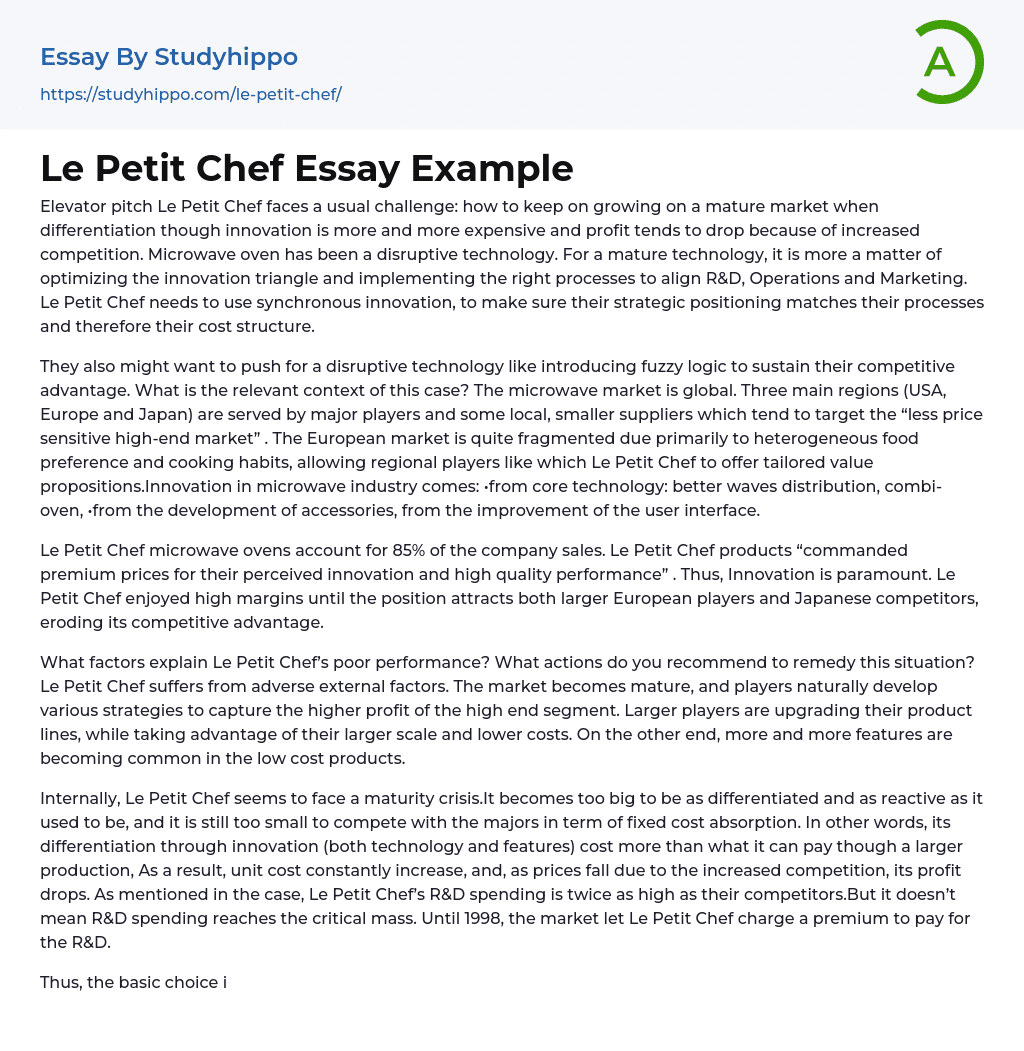Elevator pitch Le Petit Chef faces a usual challenge: how to keep on growing on a mature market when differentiation though innovation is more and more expensive and profit tends to drop because of increased competition. Microwave oven has been a disruptive technology. For a mature technology, it is more a matter of optimizing the innovation triangle and implementing the right processes to align R&D, Operations and Marketing. Le Petit Chef needs to use synchronous innovation, to make sure their strategic positioning matches their processes and therefore their cost structure.
They also might want to push for a disruptive technology like introducing fuzzy logic to sustain their competitive advantage. What is the relevant context of this case? The microwave market is global. Three main regions (USA, Europe and Japan) are served by major players and some local, smaller suppliers which tend to target the “less price sensi
...tive high-end market” . The European market is quite fragmented due primarily to heterogeneous food preference and cooking habits, allowing regional players like which Le Petit Chef to offer tailored value propositions.Innovation in microwave industry comes: •from core technology: better waves distribution, combi-oven, •from the development of accessories, from the improvement of the user interface.
Le Petit Chef microwave ovens account for 85% of the company sales. Le Petit Chef products “commanded premium prices for their perceived innovation and high quality performance” . Thus, Innovation is paramount. Le Petit Chef enjoyed high margins until the position attracts both larger European players and Japanese competitors, eroding its competitive advantage.
What factors explain Le Petit Chef’s poor performance? What actions do you recommend to remedy this situation? Le Petit Chef suffers from adverse external
factors. The market becomes mature, and players naturally develop various strategies to capture the higher profit of the high end segment. Larger players are upgrading their product lines, while taking advantage of their larger scale and lower costs. On the other end, more and more features are becoming common in the low cost products.
Internally, Le Petit Chef seems to face a maturity crisis.It becomes too big to be as differentiated and as reactive as it used to be, and it is still too small to compete with the majors in term of fixed cost absorption. In other words, its differentiation through innovation (both technology and features) cost more than what it can pay though a larger production, As a result, unit cost constantly increase, and, as prices fall due to the increased competition, its profit drops. As mentioned in the case, Le Petit Chef’s R&D spending is twice as high as their competitors.But it doesn’t mean R&D spending reaches the critical mass. Until 1998, the market let Le Petit Chef charge a premium to pay for the R&D.
Thus, the basic choice is either increase volume to keep R&D cost per unit low, or decrease the total amount of fixed costs, including R&D. Le Petit Chef’s executives first need to acknowledge this change in their market structure and adapt their processes to the new environment. The challenge is either: •continue the elitist approach of the market, which means: oincrease the R&D content of the products, and focus on higher profit, smaller segment of the market •evolve to a lower cost, more recognizable differentiation, and capitalize on Le Petit Chef brand equity to attract a larger market
with lower margin •do both: keep Le Petit Chef as such on the upper segment, and create another brand (Cuisine by Le Petit Chef, or equivalent) to attack the lower segment without endangering Le Petit Chef brand equity What should Gagne do? Specifically, what projects should she fund and why?Gagne cannot ignore the marketing department input; neither can she forget the huge return of project b. As a result, it needs to be put in front.
On the other hand of the scope, project “a” is the only one to be able to maintain Le Petit Chef’s leadership in term of technology and features. She should consider each project with regard to its positioning on the innovation triangle. Each project has an impact in term of marketing, R&D and operations. It would be useful to carefully look at the R&D department workload.
She needs to build her presentation in integrating marketing and operations inputs. Basically, she needs to presents the different options and how they would alter the course of the organization.Developing fuzzy logic could be an opportunity to take advantage of a new phase of disruptive technology to sustain a competitive advantage. As a matter of fact, fuzzy logic has been incorporated by OEMs in many appliances, starting with dryers. On the other end of the scope, the company could re-engineer there processes to re-orient its production toward low-cost product. Whatever path is chosen, the marketing channel will have to be aligned.
- Chief Executive Officer essays
- Convenience Store essays
- Firm essays
- Training And Development essays
- Unilever essays
- Variable Cost essays
- Virgin Group essays
- Bargaining essays
- Entity essays
- Pest analysis essays
- John Locke essays
- 9/11 essays
- A Good Teacher essays
- A Healthy Diet essays
- A Modest Proposal essays
- A&P essays
- Academic Achievement essays
- Achievement essays
- Achieving goals essays
- Admission essays
- Advantages And Disadvantages Of Internet essays
- Alcoholic drinks essays
- Ammonia essays
- Analytical essays
- Ancient Olympic Games essays
- APA essays
- Arabian Peninsula essays
- Argument essays
- Argumentative essays
- Art essays
- Atlantic Ocean essays
- Auto-ethnography essays
- Autobiography essays
- Ballad essays
- Batman essays
- Binge Eating essays
- Black Power Movement essays
- Blogger essays
- Body Mass Index essays
- Book I Want a Wife essays
- Boycott essays
- Breastfeeding essays
- Bulimia Nervosa essays
- Business essays
- Business Process essays
- Canterbury essays
- Carbonate essays
- Catalina de Erauso essays
- Cause and Effect essays
- Cesar Chavez essays




